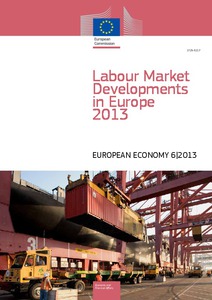Labour market developments in Europe 2013
"In 2012, the unemployment rate in the EU and the euro area continued to climb further until early 2013, reaching values above 11 and 12% respectively. Labour dynamics continued to differ substantially across countries and the patterns of labour market dynamics across the EU further contributed...
| Institution: | ETUI-European Trade Union Institute |
|---|---|
| Format: | TEXT |
| Language: | English |
| Published: |
Luxembourg
2013
Publications Office of the European Union |
| Subjects: | |
| Online Access: | https://www.labourline.org/KENTIKA-19123151124919413339-Labour-market-developments-in-.htm |
| Summary: | "In 2012, the unemployment rate in the EU and the euro area continued to climb further until early 2013, reaching values above 11 and 12% respectively. Labour dynamics continued to differ substantially across countries and the patterns of labour market dynamics across the EU further contributed to increasing the already high degree of dispersion of unemployment rates. Activity rates kept being resilient, but ‘discouraged worker effects’ are becoming stronger over time, in particular in the countries characterised by the highest shares of long-term unemployment.
While the first quarter of 2013 was characterised by a severe GDP contraction and a widespread rise in unemployment rates, quarter-on-quarter growth turned positive in the second quarter, technically putting an end to the recession. A halt to unemployment growth was recorded since March 2013 both for the EU and the euro area aggregate, but it is early to judge if these recent developments prelude to an inversion of the upward trend in unemployment rates. The employment prospects of the young have deteriorated substantially since the crisis in light of the strong sensitiveness of youth unemployment to economic activity, and the growing long-term unemployment is contributing to an aggravating poverty problem in some countries.
Despite rising unit labour costs linked to falling labour productivity in the recession, wage growth remained subdued, also in light of the moderate dynamics of government sector compensations in some countries. Also in 2012, as it was the case in 2011, real unit labour costs are on average declining faster in countries with higher unemployment rates, which appears supportive to the reduction of unemployment divergences. It is also confirmed for 2012 the tendency for unit labour costs to fall stronger in countries having to rebalance their economies after periods of large current account deficits before the crisis.
The policy response put in place by EU Member States and EU institutions in recent years was broadly adequate and commensurate with the challenges and the resistance to reforms long overdue was overcome in a number of countries. Nonetheless, policy action to tackle unemployment should continue aiming sufficiently high. This is key to ensure a proper response of labour markets to the major shocks ensuing from the crisis, to tackle the social implications of the crisis, and to prevent a persistent fall in the labour contribution to growth looking forward.
Analytical focus: Cyclical and structural unemployment in the EU
The high and persistent unemployment rate in most EU countries has prompted concerns that the underlying structural unemployment has shifted upwards and that the increase in unemployment could persist once the recovery is on a solid footing. The question is of key relevance, as assessing whether unemployment is mostly cyclical or structural has implications for the policy response needed to address the unemployment problem. The analysis in the report shows that not only the level, but also the structure of unemployment and the extent to which it is structural differs widely across countries. It follows that policy responses across the board for the EU or the euro area would work only to a certain extent, since the magnitude and typology of challenges are largely country-specific. It also appears that cyclical unemployment may in some cases be above what suggested by common estimates of structural unemployment, which has positive implications for the effectiveness of macro and micro policies stimulating labour demand and favouring wage adjustment. There is nonetheless evidence of worsening labour market matching and growing structural unemployment of persistent nature in a number of countries, mostly driven mismatch across skills and sectors, and an increased duration of unemployment spells.
" |
|---|---|
| Physical Description: | 133 p. Digital |

